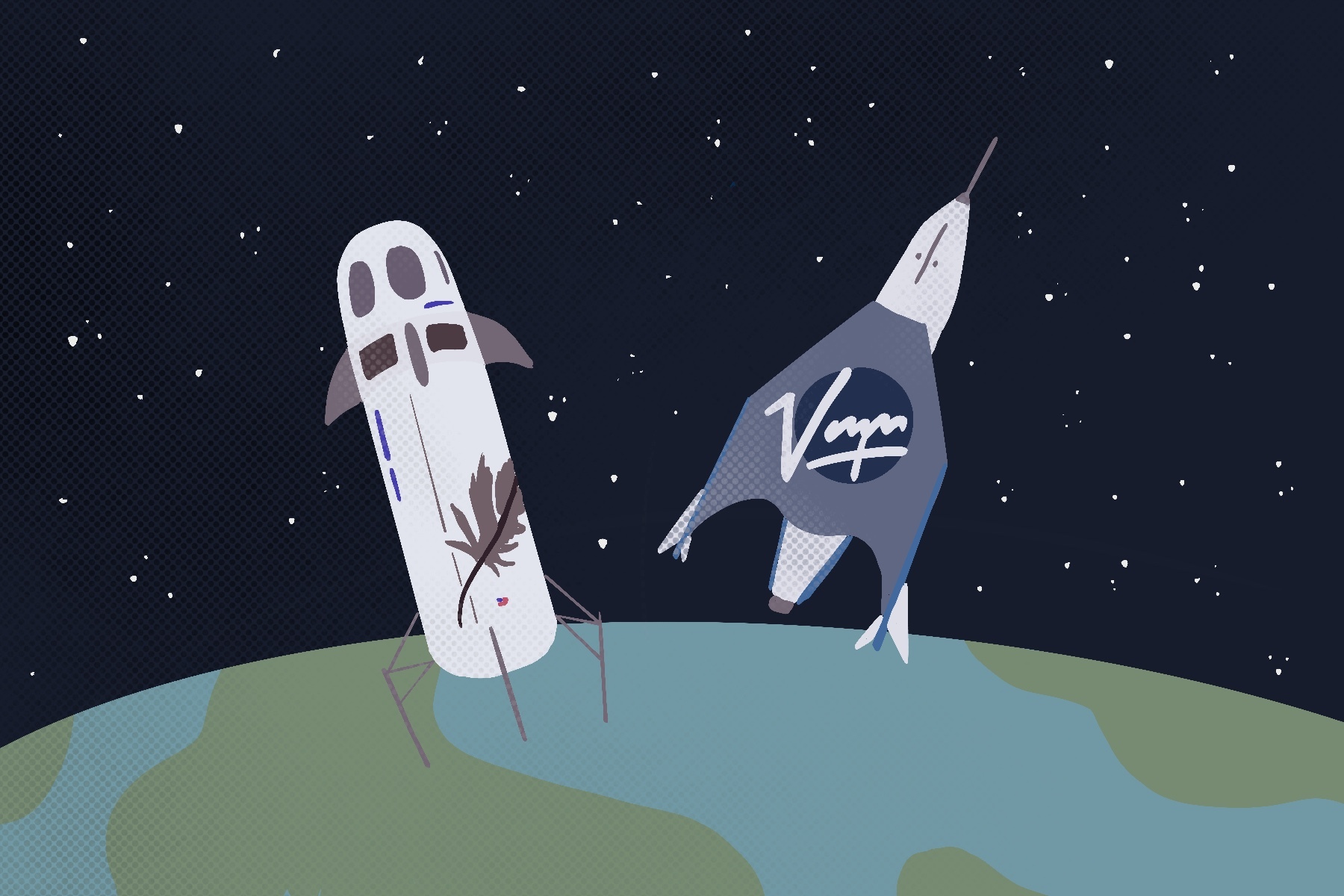The town of Van Horn is about as unassuming as small Texas towns come. Located on a 3-square-mile oasis in the West Texas desert with a population of roughly 1,800 people, the sleepy community is nearly identical to the many other small Western villages that dot the Southwest. The streets of Van Horn, lined with low-slung storefronts and dilapidated ranches, keep most residents’ eyes close to the ground, but one notable event recently gave locals a reason to set their sights high.
On July 20, a crew of four civilians left the Earth’s surface in a rocket launched from Van Horn and traveled 66 miles above the Earth’s surface into space. The crew, which was not comprised of professional astronauts, was notably eclectic as it included a teenager, an 82-year-old aviator and Amazon founder Jeff Bezos.
The ship the group boarded, New Shepard, was constructed by Blue Origin, a private aerospace corporation and one of Bezos’ lesser-known firms. The successful mission was a proof of concept to grow public awareness of Blue Origin’s aspirations and affirm Bezos’ claim to a share of the budding space tourism industry.
Bezos has little connection to the dusty plains of rural Texas, despite what the comically out-of-place cowboy hat he wore for press interviews might imply. Bezos, the founder and executive chairman of Amazon, is the wealthiest man on the planet with a current net worth of $211 billion. After the growth of Amazon, Bezos founded Blue Origin in 2000, a corporation dedicated to facilitating commercial spaceflight.
New Shepard’s July 20 mission is an initial step toward this goal — a step that has only fueled Bezos’ hunger for more ambitious projects. In a CNBC video interview, Bezos pitched the New Glenn project, which will launch a reusable spacecraft into orbit around the Earth. As with the space race of the 20th century, these are baby steps toward his eventual goal of creating a substantial network of spacefaring technology.
Bezos was brimming with confidence and braggadocio in the interviews following New Shepard’s landing, yet for all the posturing, his achievement has been slightly overshadowed by an earlier flight. On July 11, nine days before Bezos suited up to enter space, Virgin Galactic founder Richard Branson and three employees joined two pilots on a flight aboard the V.S.S. Unity, a rocket-propelled plane that flew 50 miles above the Earth’s surface.
As the first of the two flights, the Unity launch drew abundant press coverage and was packaged as the first true demonstration of suborbital space travel. Branson, an aging British billionaire who earned his fortune as the founder of numerous Virgin Group companies, views his recent journey to space as the genesis of a new space age that can inspire both scientific research and recreational travel beyond the atmosphere.
The two missions shared a pronounced sense of jubilation and wonderment, best captured by the cameras placed in the vessels’ cabins. Upon entering a state of weightlessness aboard the Unity, Branson launched into a melodramatic monologue proclaiming, “I was once a child with a dream, looking up to the stars. Now I’m an adult in a spaceship, with lots of other wonderful adults, looking down to our beautiful, beautiful Earth.” His words certainly add an emotional gravity to his momentary weightlessness, though it is hard to become engrossed in his speech while several of his fellow crewmates fly about beside him in fits of laughter.
The scene within New Shepard was even less serious, with the crew more preoccupied with the amusing physics of floating ping pong balls than an exchange of weighty commentary. The exaggerated awe expressed by both crews seems to embody the crossing of a new threshold for mankind, yet neither company truly broke new ground.
On paper, little of either mission to space can be considered revolutionary. In 1961, Russian pilot Yuri Gagarin became the first man to enter space and orbit the Earth in the same flight. In the years since Gagarin’s orbit, hundreds of astronauts have entered space, traveling beyond Earth’s atmosphere on a variety of craft produced by several space agencies around the world. Both crews sent into space this July had vastly shorter training regimens and were not comprised of career astronauts, yet the technological dimension of their accomplishments is largely a retread of previous programs.
The two entrepreneurs are nonetheless eager to flaunt the comparative advantages of their vehicles, engaging in a quasi-debate that drew public focus to their competition. One of the focal points of the discourse lies in the craft types each company employed for their flights. Blue Origin’s New Shepard is reminiscent of traditional rockets used by most space agencies, including NASA, while Virgin Galactic’s Unity adopted a plane-like fuselage. The difference in construction represents an optical divergence, with Blue Origin priding itself on its purist rocketry aesthetic.
Another key point of comparison is the height at which each vessel settled above the Earth, with New Shepard rising 10 miles above the Unity. Blue Origin’s Twitter account was eager to assert its supposedly more legitimate altitude, citing the higher Kármán line as the real boundary of space. To cement its jab at Virgin Galactic, the account responded to its original post with a comment exclaiming that its more commendable agenda is “one of the many benefits of flying with Blue Origin.”
Both companies are jockeying to be seen as the champion of a new frontier for transportation, though who exactly will be able to experience the “many benefits” offered by either is not yet clear. The chief executive of Blue Origin has stated that future tickets “are going for a very good price” but did not offer any specific numbers. Virgin Galactic has been more open about its extravagant pricing, offering single seats for between $200,000 and $250,000 during the original sale period.
Exorbitantly high prices are enough to disqualify most Americans from ever being able to board future spaceflights, and for those who can, there aren’t many tangible reasons to make the investment. The commercial space tourism that the two companies seek to develop would simply entail more suborbital flights similar to the July missions.
The elitist culture that will result from a select group of wealthy individuals taking aimless journeys to the boundary of space will give the average American little reason to be invested in the future of space exploration. Blue Origin will have an especially difficult time engaging the public due to the baggage that its founder’s reputation unfortunately brings to the table.
Bezos has been shrouded by controversy in recent years as detailed reports of Amazon’s employment culture have painted a damning picture of the company’s internal workings. Numerous Amazon warehouse workers have spoken out in recent months about cruel working conditions that have been intentionally devised to maximize productivity at the expense of basic workers’ rights.
The culture of abuse extends into the corporate sphere of the company, as revealed by reports of systemic suppression of harassment complaints within Amazon’s Web Services department. Blue Origin is a distinct corporation, yet Bezos’ position as its figurehead complicates its public image at a moment when it is trying to promote its brand and vision to all Americans. If the cost of a ticket and the minimal utility of further flights does not dissuade the public from buying into the visions put forth by Bezos, his track record with the people that are essential to his businesses may be enough to shoot down his astronomically grand vision.
Virgin Galactic and Blue Origin undoubtedly have a lot on their plates now. Their lofty goals and faltering public images are clear liabilities, but their stated next steps are a promising sign. Blue Origin has been working closely with NASA in a partnership to conduct research via its forthcoming New Glenn project and may be responsible for designing the Artemis lander that will be used for the first crewed moon landing in more than 50 years.
Both initiatives are practical and are reinforced by a federal agency, promising features for those worried about the company’s trajectory. Virgin Galactic will continue to launch spaceplanes for scientific research, hoping to capitalize on “the benefits of rapid learning and improvement” that such an approach can yield.
It is encouraging for the scientific community that Bezos and Branson will not continue to engage in a rat race of one-upmanship, instead homing in on different segments of the aerospace field. Both men have invested countless hours and dollars into technology that has the potential to expand humanity’s relationship with the vacuum beyond Earth’s atmosphere. Their pragmatism can ensure a return on this investment, pulling the vastness of space just a bit closer to the reach of many.

















